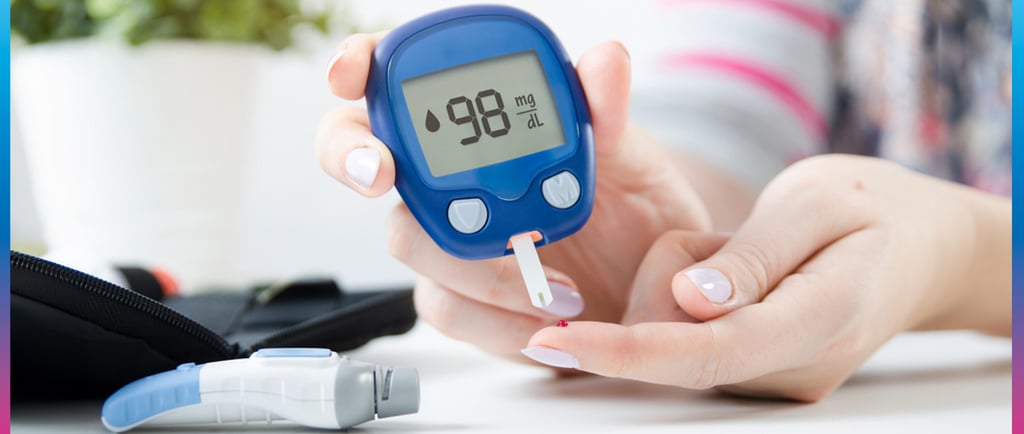7 Powerful Natural Ways to Manage Blood Sugar Levels Effectively
Struggling with blood sugar spikes? Discover 7 proven, natural strategies to gain control. This ultimate guide explains the science behind how stress, meditation, daily movement, and dietary choices directly impact your glucose levels and insulin sensitivity. Learn practical steps you can start today to support your metabolic health without drastic measures.
SOCIAL


Managing blood sugar is a cornerstone of overall health, crucial for sustaining energy, maintaining a healthy weight, and supporting long-term well-being. While medication is necessary for some, powerful natural lifestyle changes can have a profound impact on your body's ability to regulate glucose.
This guide moves beyond simple tips to provide a deep dive into seven evidence-based strategies that address the root causes of blood sugar dysregulation. By understanding the 'why' behind each method, you can empower yourself to take control of your metabolic health.
1. Stress Less, Live More: The Cortisol-Blood Sugar Connection
Stress is far more than a mental state; it triggers a tangible physiological cascade that directly impacts your blood sugar. When you encounter stress, your body enters "fight or flight" mode, releasing hormones like cortisol and adrenaline.
The Science: These hormones are designed to provide immediate energy. They signal your liver to release stored glucose into your bloodstream. For our ancestors, this was essential for escaping danger. In modern life, chronic stress from work, relationships, or traffic leads to persistently elevated blood sugar levels, forcing your pancreas to produce more insulin and leading to potential insulin resistance over time.
Actionable Steps to Manage Stress:
Identify Triggers: Keep a journal for a week. Note when you feel stressed and what caused it. Awareness is the first step to management.
Practice Deep Breathing: The 4-7-8 technique (inhale for 4 seconds, hold for 7, exhale for 8) activates the parasympathetic nervous system, countering the stress response.
Learn to Say "No": Overcommitting is a major source of chronic stress. Setting boundaries is not selfish—it's essential for your health.
Connect with Others: Social support is a powerful buffer against stress's negative effects.
2. The Daily Ritual of Meditation: Calming Your Mind to Steady Your Glucose
Meditation is a practical tool for rewiring your brain's response to stress, thereby indirectly regulating blood sugar.
The Science: Regular meditation practice has been shown to lower cortisol levels, reduce inflammation, and improve overall metabolic function. A study published in the journal Psychoneuroendocrinology found that mindfulness meditation can improve fasting blood glucose and HbA1c levels in individuals with type 2 diabetes.
How to Get Started (You Don't Need to Be a Monk):
Start Small: Begin with just 5 minutes each morning. Consistency is more important than duration.
Use Guided Apps: Apps like Calm, Headspace, or Insight Timer offer excellent beginner-friendly guided sessions focused on stress reduction and body awareness.
Focus on the Breath: Simply sit quietly and pay attention to your inhalation and exhalation. When your mind wanders (which it will), gently bring it back to your breath without judgment.
3. Move Your Body—Every Day: The Exercise-Insulin Synergy
Physical activity is one of the most potent tools for improving insulin sensitivity. Your muscles are your largest organ, and when they contract, they can take up glucose from the blood without needing insulin.
The Science: Exercise makes your muscle cells more responsive to insulin, meaning your body needs to produce less of it to manage the same amount of glucose. This effect can last for hours after your workout.
Practical Ways to Incorporate Movement:
Find What You Enjoy: You don't need to run marathons. Brisk walking, cycling, swimming, dancing, or even gardening count.
Aim for Consistency: The American Diabetes Association recommends at least 150 minutes of moderate-intensity exercise per week. That breaks down to just 30 minutes, 5 days a week.
Incorporate Strength Training: Building muscle mass increases your body's glucose storage capacity. Aim for resistance exercises 2-3 times per week.
4. The Post-Meal Walk: A Simple Hack for Dramatic Results
A short walk after eating is a surprisingly effective strategy for mitigating blood sugar spikes.
The Science: When you eat, your blood glucose naturally rises. Muscle contractions from walking help shuttle this glucose into your muscle cells to be used for energy, significantly blunting the postprandial (after-meal) spike. Research shows that a 10-15 minute walk after each main meal can be more effective for glycemic control than a single 45-minute walk at another time of day.
How to Implement It: Make it a non-negotiable part of your routine. After lunch and dinner, step outside for a brief, leisurely stroll. It aids digestion, manages blood sugar, and provides a mental break.
5. Ditch the Packaged Foods: Embrace Whole Food Nutrition
Processed and packaged foods are the primary source of hidden sugars, refined carbohydrates, and unhealthy fats that wreak havoc on blood sugar control.
The Science: These foods are engineered for hyper-palatability, causing overconsumption. They are often high in high-fructose corn syrup and refined flour, which are rapidly digested, causing sharp spikes and crashes in blood sugar.
What to Swap:
Instead of crackers or chips: snack on a handful of nuts, carrot sticks, or an apple.
Instead of sugary breakfast cereal: opt for plain oatmeal topped with berries and nuts.
Instead of white bread: choose whole-grain or sourdough options with higher fiber.
Focus on a Plate Method: Fill half your plate with non-starchy vegetables, a quarter with lean protein (chicken, fish, tofu), and a quarter with high-fiber carbohydrates (quinoa, sweet potato, beans).
6. Mind Your Caloric Intake: The Foundation of Metabolic Health
Consistently consuming more calories than your body needs leads to weight gain, particularly visceral fat around the organs, which is highly inflammatory and contributes significantly to insulin resistance.
The Science: Excess adipose (fat) tissue releases inflammatory cytokines and free fatty acids into the bloodstream, which interfere with insulin signaling. Even a 5-10% reduction in body weight can dramatically improve insulin sensitivity.
How to Practice Calorie Awareness:
Use Portion Control: Use smaller plates, measure servings initially, and be mindful of restaurant portions, which are often oversized.
Avoid Mindless Eating: Don't eat straight from the bag. Portion out snacks and sit down to enjoy them.
Listen to Hunger Cues: Eat slowly and stop when you are 80% full. It takes about 20 minutes for your brain to register fullness.
7. Combat Sitting Disease: The Power of Non-Exercise Activity Thermogenesis (NEAT)
Your structured workout is important, but what you do for the other 23 hours of the day matters just as much. This is called NEAT—the energy expended for everything we do that is not sleeping, eating, or sports-like exercise.
The Science: Prolonged sitting has been independently linked to poor metabolic health. Frequent, low-intensity movement throughout the day keeps your muscles engaged and your metabolism active, preventing blood sugar from settling at high levels.
Simple Ways to Increase NEAT:
Set a timer to stand up and stretch every 30 minutes.
Take phone calls while walking.
Park farther away from entrances.
Use a standing desk if possible.
Do a few bodyweight squats or calf raises while waiting for your coffee to brew.
